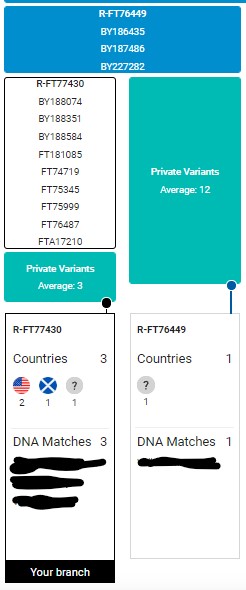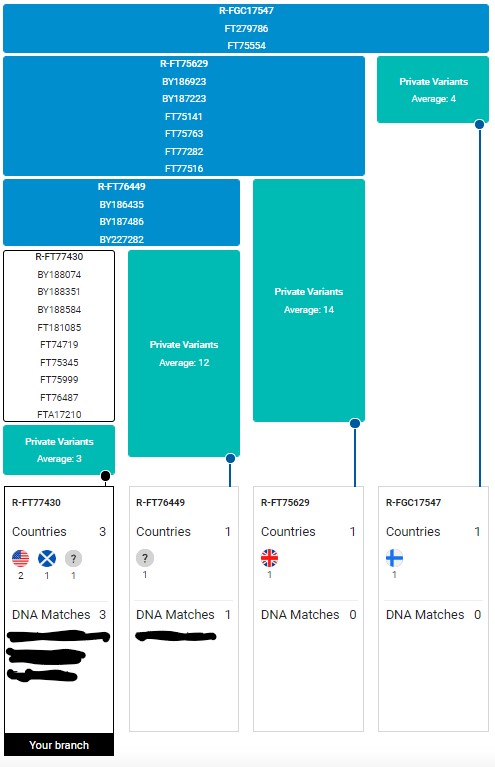Although there is nothing particularly revealing in the latest Block Tree in my FTDNA Big-Y results, there are some interesting aspects that are worth looking at in a post here. The hope is that as more men take the Big-Y, we will start to see some closer matches that narrow down our more distant Wilson ancestry.
But first, some recap and background information. As I have mentioned in other posts, the Big-Y 700 test from FTDNA (familytreedna.com) provides the most accurate grouping of testers into haplogroups based on their Y-DNA (direct male) line. As the name indicates, FTDNA examines about 700 SNPs (single nucleotide polymorphisms) on the Y-DNA chromosome. SNPs mutate at a fairly low rate from a reference chromosome (currently estimated between 83 and 144 years, or 4-5 generations) and provide a fingerprint for each tester that can be used to place him in a group of related testers. An individual may have some number of “private variants” that are only present in his mutation map, depending on how closely related he is to other testers. For example, if my father or son were to be tested, it we would likely have 0 (zero) private variants between us according to the average mutation rate. However, it is possible that one of us might have a mutation in our chromosome that makes us different from our father – after all, the mutations do have to occur sometime, but the odds of a mutation in any given generation are roughly 20-25%. I guess it is theoretically possible to have more than one mutation in a generation but I have not seen any statistics on this.
One other thing to note is that a mutation may or not be “named”. If a mutation is shared by two or more testers, it is given a name such as FT-77430 and “placed” on a master haplogroup tree (which is called the Big-Y Block Tree at FTDNA). Conversely, a variant that only occurs in 1 man is called a private variant as discussed above and is not named, only referenced by a number such as 2788335. As a result it is possible to use the number of private variants to estimate the number of years (or generations) back to a common ancestor for a group of “matched” testers. Specifically for our small haplogroup, there are four of us with James Wilson Sr. as a common ancestor; according to FTDNA, there is an average of 3 private variants among us. Using the current best estimates of 83-144 years between mutations, our common ancestor would have been born between 3*83=249 and 3*144=432 years ago. James Sr. does seem to fit in this range as he was probably born in the early 1700’s, which would have been about 250 years before the 4 of us.
Below is a snapshot of our portion of the block tree zoomed into our little family group (I have redacted the names of my matches, but they know who they are :-))

As you can see, we each have about 3 private variants among us – since they are private and thus unnamed, we know that each of our ~3 is different than the others. I believe that each of the other 3 is descended from James’ son Moses, whereas I am from Moses’ brother Thomas. Since all of the 3 likely have a common ancestor one generation closer than they do with me, it is possible they could have an extra mutation in common if such had occurred in Moses. However, this doesn’t seem to be the case since if they did they would be grouped in the own named haplogroup separate from me. This would mean that James, Moses and Thomas all had identical Y-DNA SNP’s which only mutated later in our separate lines.
Another thing to note from this segment of the block tree: there are 10 variants all 4 of us share that are different than our next closest relative who has tested (more on him below). No other tester yet has these variants, but they are named since 4 of us do. Without an additional match with some (but not all) of these mutations, FTDNA has no idea what order each of these 10 mutations were formed, and so they are grouped in a block which is given the name of one them (picked randomly? I’m not sure) – in our case, R-FT77430. What we would like to see is a more recent common relative get BigY test results which would “break up” this block, which could be particularly useful if this man had knowledge about his ancestral male Y-DNA line. We can see this type of thing in action if we move farther up the block tree:

Here you can see another tester that shared an additional 4 variants but has 12 private variants of his own. This closely matches the 13 variants we 4 James Wilson descendants share. Something particularly interesting about this tester (we’ll call him Bill) is that he has traced his male line back to a John Fairchild that was transported from London to Australia (as a convict) in 1830. Now, I have a firm belief that our James Sr. was Scottish or Scotch-Irish (which I will discuss in more detail in another post soon); at first glance a match to man in London might tend to disprove that. However, note that our common ancestor with Bill was 12-13 mutations ago, who would have been born well over 1000 years ago. Not only was this before surnames were in common use (thus the lack of a known Wilson in Bill’s line), but it could easily have been a man whose descendants spread far and wide through what is now the UK and Ireland – perhaps even a roving Viking invader! But unfortunately, Bill’s results don’t really tell us too much other than they don’t disprove my theory of Scottish/Irish ancestry.
Let’s look at 1 final segment of the Big-Y block tree:

A few more variants away from Bill is a tester who believes he had an ancestor from England, which seems perfectly consistent with our other clues. That particular common ancestor to us and Bill would have been born around and at least 500 years before our supposed Viking invader – probably on the continent or in Scandinavia. I have no other information on this tester. However, the tester next to him is from Finland and believes his ancestors (as far as he can track) are also Finnish. Our common Gx-grandfather with this fine Finn was probably another 1000 years previous, or more than 2500 years ago! Once again, that lineage, which might well have been one of the Bronze Age tribes in central or north Europe, is not inconsistent with our idea of being of Scotch/Irish/Viking blood.
Speaking of Vikings, there is another website I use called mytrueancestry.com that provide analysis and matching of submitted DNA with known samples from ancient gravesites. Although they don’t seem to recognize haplogroups later than FGC-17519, which is a mutation earlier than the FGC-17547 at the top of our chart above, probably approaching 3000 years ago, they do show “matches” that seem to be from more recent eras. One in particular in my list is from a Viking Era sample. It is unclear from their “documentation” (I use the term loosely, as very little is explained about the so-called matches) how closely it matches me, but we likely have a common ancestor at least as late as the Bronze Age — a very long time ago nonetheless. All this tells us is that some of our ancient pre-Wilson ancestors produced lines that evolved into Vikings (as well as Longobords and Scottish clansmen, among others) which once again is consistent with my loosely supported theories.

Once again I am in awe of the knowledge you have regarding DNA. I am grateful for your hard work and sharing of the information. You have helped us discover more about our ancestors and advanced our genealogy work. As always I will be looking forward to your next post.
John Culpepper Wilson descendant
Beth Barnett.